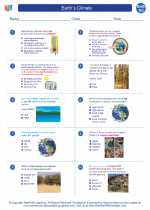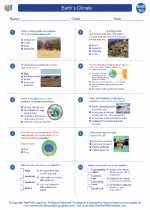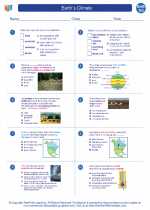Earth`s Climate -> weather patterns
Weather Patterns
Weather patterns refer to the variations and changes in weather conditions over a period of time. These patterns are influenced by a variety of factors, including temperature, air pressure, humidity, and wind. Understanding weather patterns is important for predicting and preparing for different weather conditions, such as rain, snow, thunderstorms, and hurricanes.
Factors Affecting Weather Patterns
1. Temperature: Temperature variations play a significant role in shaping weather patterns. Warmer air tends to rise, creating areas of low pressure, while cooler air sinks, leading to areas of high pressure. This temperature difference drives the movement of air masses, which in turn influences weather patterns.
2. Air Pressure: Variations in air pressure can lead to the formation of high and low-pressure systems, which are associated with different weather conditions. High-pressure systems typically bring clear skies and dry weather, while low-pressure systems are associated with cloudy, stormy conditions.
3. Humidity: The amount of water vapor in the air, or humidity, affects the likelihood of precipitation. High humidity levels can lead to the formation of clouds and precipitation, while low humidity levels generally result in dry conditions.
4. Wind: Wind patterns play a crucial role in shaping weather conditions. The movement of air masses, driven by differences in temperature and pressure, influences the direction and intensity of winds, which in turn impact weather patterns.
Types of Weather Patterns
1. Frontal Systems: Frontal systems occur at the boundaries between air masses with different temperatures and humidity levels. These boundaries can lead to the formation of clouds, precipitation, and changes in temperature and wind patterns.
2. Cyclones and Anticyclones: Cyclones are areas of low pressure, often associated with stormy weather, while anticyclones are areas of high pressure, typically bringing calm, clear conditions.
3. Global Wind Patterns: The Earth's rotation and variations in temperature drive global wind patterns, such as the trade winds and westerlies, which influence weather patterns across different regions.
Studying Weather Patterns
1. Observation: Take note of the weather conditions in your area over an extended period. Record temperature variations, cloud cover, precipitation, and wind patterns to identify recurring weather patterns.
2. Weather Maps: Study weather maps to understand the movement of air masses, pressure systems, and frontal boundaries. Analyze the relationship between these features and the resulting weather patterns.
3. Climate Data: Examine historical climate data to identify long-term weather patterns and trends. Look for seasonal variations and recurring weather phenomena in your region.
4. Technology: Utilize weather forecasting tools and technology to track and analyze current weather patterns. Explore online resources, satellite imagery, and radar data to understand the dynamics of weather systems.
By understanding the factors influencing weather patterns and studying their characteristics, you can gain insights into predicting and interpreting various weather conditions.
[Weather Patterns] Related Worksheets and Study Guides:
.◂Earth Science Worksheets and Study Guides High School. Earth`s Climate

 Worksheet/Answer key
Worksheet/Answer key
 Worksheet/Answer key
Worksheet/Answer key
 Vocabulary/Answer key
Vocabulary/Answer key
 Vocabulary/Answer key
Vocabulary/Answer key
 Vocabulary/Answer key
Vocabulary/Answer key
